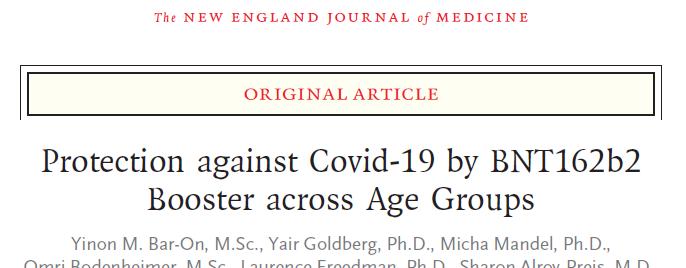▎ WuXi AppTec content team editor
Recently, the leading medical journal New England Journal of Medicine (NEJM) published a real-world study from Israel. An analysis of data from more than 4.69 million ≥ 16-year-old individuals showed that the risk of infection after vaccination was much lower in all age groups and the overall risk of infection was 10-fold lower in all age groups than with the two-dose BNT162b2 conventional vaccine. In addition, after vaccination, the severe illness rate and mortality rate of the middle-aged and elderly population have also been greatly reduced.
According to the NEJM contemporaneous editorial, the results of this study, along with other data being collected, provide reference data for the global ongoing intensification of vaccination.

截图来源:The New England Journal of Medicine
Since June this year, Israel has gradually initiated the vaccination of the third (booster) BNT162b2 COVID-19 vaccine for people of all ages. The analysis, which collected data from the Israeli Ministry of Health database for the period between July 30 and October 10, 2021, covered 4.697 million individuals ≥ 16 years of age who had completed two doses of BNT162b2 at least five months before the start of the study.
The main analysis of the study was the confirmed, severe and mortality rates of COVID-19 infection compared to those who had been vaccinated for 12 days and those who had not been vaccinated with intensive needles. The secondary analysis is to compare the above indicators in people who have been vaccinated for 12 days and 3-7 days after receiving booster needles.
WuXi AppTec content team mapping
The results showed that compared with the two injections, the confirmed infection rate was 10 times lower than that of people who had been vaccinated for 12 days.
Consistent trends were observed in all 5 age groups.
≥ 60 years old: 12.3 times lower
50-59 years old: 12.2 times lower
40-49 years old: 9.7 times lower
30-39 years old: 9.0 times lower
16-29 years old: 17.2 times lower
Compared with the 3-7 days after the intensive injection, the confirmed infection rate was 4.9-10.8 times lower for the people who had been vaccinated for 12 days. Similarly, the difference in effect was most pronounced among people aged 16-29 years.
▲Unvaccinated booster injection (Nonbooster), 12 days after vaccination booster, 3-7 days after vaccination booster injection (Early Postbooster), infection rate of people of different age groups (Image source: Reference[1])
From the severity of post-infection:
Among ≥ 60-year-olds, compared with those who received 3-7 days after receiving two and booster needles, and who had been vaccinated with intensive injections for 12 days, the incidence of severe disease was 17.9 times and 6.5 times lower, and the mortality rate was 14.7 times and 4.9 times lower, respectively.
Among people aged 40-59 years, the incidence of severe disease was 21.7 times lower than that of those who had been vaccinated for 12 days after receiving two injections and 3-7 days after receiving booster needles, respectively.
The paper concludes that the results of this study provide evidence for the short-term effectiveness of the booster needle in ≥16-year-olds against the Delta variant, and future studies need to focus on the long-term effectiveness of the booster needle and its effect on the new variant.